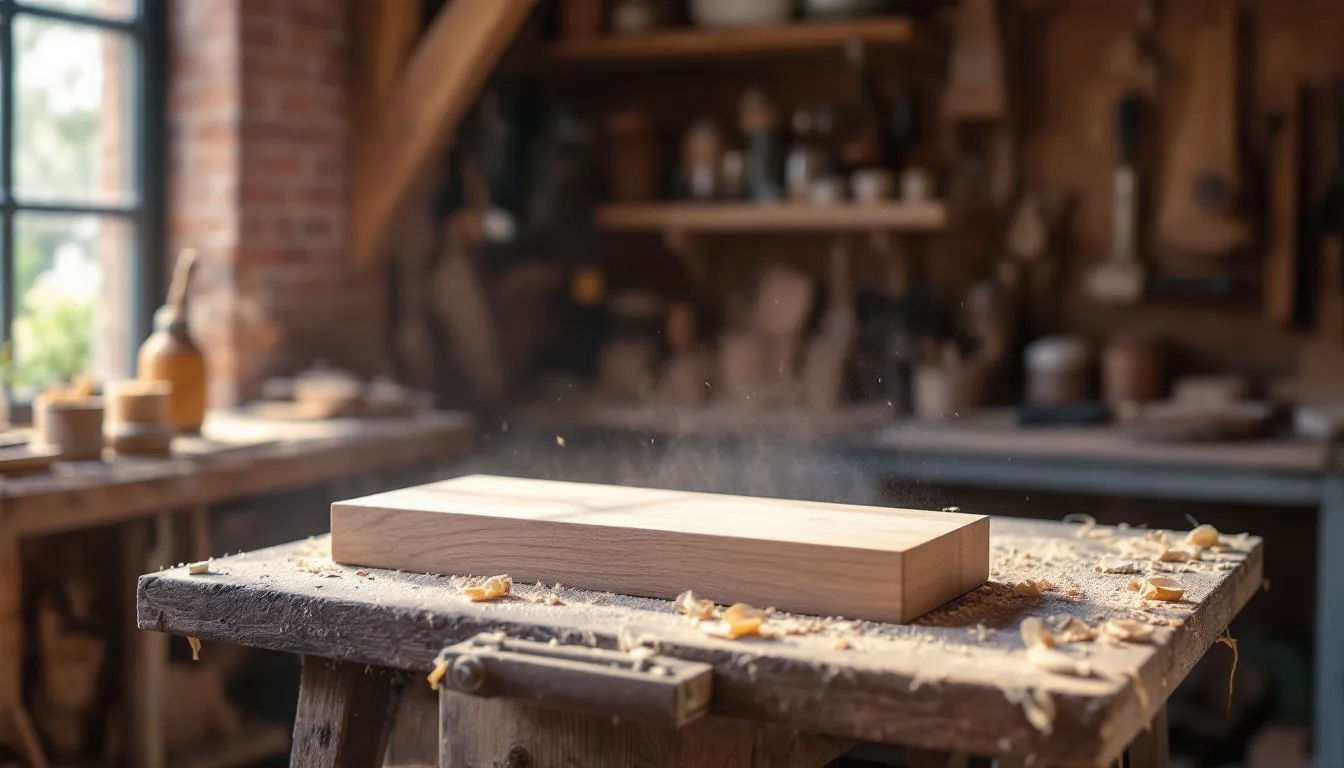The Einhell TC-SP 204 Planer Thicknesser Review: A British Woodworker’s Guide
Our comprehensive review of the Einhell TC-SP 204 planer thicknesser, breaking down its features, performance, and value for British DIY and woodworking fans.

This post may contain affiliate links. If you make a purchase through these links, we may earn a commission at no additional cost to you.
There’s a special kind of magic in taking a rough, wonky bit of wood and turning it into something perfectly smooth, flat, and true. It’s the starting point for almost every great woodworking project, from a simple garden planter to a grand dining table. For years, this was the work of hand planes and a whole lot of elbow grease—a skill that took ages to master. But what if you could get those perfect surfaces in minutes, not hours? That’s the promise of a planer thicknesser, a machine that’s become a real game-changer in home workshops up and down the UK.
-
Powerful 1500W motor makes light work of straightening uneven wooden surfaces.
-
Features a sturdy design with pull-out workpiece supports and an aluminium surfacing plane table with a tiltable stop.
-
Vibration-absorbing legs provide extra stability during use.
-
Includes an integrated 100mm connection for a chip extractor system.
-
Equipped with an overload switch and a zero voltage switch for user safety.
Enter the Einhell TC-SP 204. It’s a bright red machine that you’ve probably seen online or in DIY catalogues. It’s aimed squarely at hobbyist woodworkers and serious DIYers—people who want to take their projects to the next level without spending a fortune. But is it any good? Does it deliver on its promise of turning rough timber into build-ready boards?
This guide is here to answer just that. We’re going to take a really deep dive into the Einhell TC-SP 204. We’ll look at what it does, how it works, what it’s good at, and where it falls short. We’ll cover everything from unboxing it in your shed to making your first cuts, and we’ll even tackle some of the common grumbles and clever fixes that users have discovered. By the end, you’ll know whether this is the right machine to earn a spot in your workshop.
What Exactly Is a Planer Thicknesser?
Before we get into the nuts and bolts of the Einhell machine, let’s quickly get our heads around what a planer thicknesser actually does. It’s basically two tools cleverly squeezed into one body to save space, which is something anyone with a typical British garage or shed workshop can appreciate.
Think of it like this: you’ve just bought some rough sawn timber from the woodyard. It’s cheaper than the perfectly prepared stuff you’d get from B&Q, but it’s a bit hairy, possibly bowed or twisted, and not a consistent thickness. This is where the planer thicknesser becomes your best friend.
The Planer (or Jointer)
The first tool is the planer, which sits on top of the machine. In America, they call this a jointer. Its job is to create one perfectly flat face on a piece of wood. You slide the board over a spinning block of sharp knives (the cutter block), and it shaves off the high spots. Once you have one flat face, you then turn the board on its edge and run it across the planer again to make that edge perfectly square (at a 90-degree angle) to the first face.
Imagine you’re trying to make a wobbly table steady. You’d shave a bit off the bottom of the longest leg. A planer does the same thing, but for the entire surface of a board, creating a dead-flat foundation to work from.
The Thicknesser
The second tool is the thicknesser, which is located underneath the planer beds. Its job is simple: to make the second face of your board perfectly parallel to the first flat face you just created, and to bring the wood down to a specific, consistent thickness.
You feed your board into a slot, with the flat face you made on the planer facing down. Rollers inside grab the wood and pull it through, passing it under the same spinning cutter block. You can adjust the height of this cutter block with a handle, allowing you to shave off a little bit of wood at a time until the entire board is exactly the thickness you want.
So, the process is always the same:
- Plane one flat face.
- Plane one square edge.
- Thickness the second face parallel to the first.
- Use a table saw to rip the final edge parallel to the second.
After these four steps, you have what woodworkers call a “dimensioned” or “S4S” (surfaced four sides) board. It’s flat, square, and ready for you to build with. The Einhell TC-SP 204 combines both the planer and thicknesser functions into a single, compact unit.
Meet the Einhell TC-SP 204: First Impressions
Let’s get our hands on the machine itself. The Einhell TC-SP 204 is what’s known as a “benchtop” planer thicknesser. It’s designed to be portable (just about!) and sit on a sturdy workbench rather than taking up permanent floor space like a massive industrial machine.
Unboxing and Assembly
When it arrives, it’s a heavy beast. At around 27 kg, you’ll want a bit of help getting it out of the box and onto your bench. Inside, you’ll find the main unit, a fence for the planer, a dust chute, and a few other bits and bobs like a push stick.
Assembly is fairly straightforward, though the instruction manual gets mixed reviews. Many British users find it’s a classic case of pictures-over-words, and it can be a bit of a head-scratcher. Your best bet is to take your time and maybe even look up a setup video on YouTube. The main tasks are attaching the fence, the handle for the thicknesser adjustment, and sorting out the dust extraction hood.
Right away, you’ll notice the signature Einhell red and black colour scheme. The overall build is a mix of cast aluminium for the tables and steel and plastic for the body. It feels solid enough for its price point. It’s not a £2,000 professional machine, and it doesn’t pretend to be. The design is compact and very much focused on the home user.
Key Specifications at a Glance
Let’s break down the important numbers. These tell you what the machine is capable of.
- Power: 1500W motor. This is a decent amount of power for a hobby machine, capable of handling softwoods like pine and even hardwoods like oak if you’re sensible with it.
- Cutter Block Speed: 9,000 RPM (revolutions per minute). This is the speed the knives are spinning. A higher speed generally means a smoother cut.
- Number of Knives: Two. The cutter block holds two straight High-Speed Steel (HSS) blades.
- Max Planing Width: 204mm (about 8 inches). This is the widest board you can flatten on the top planer.
- Max Thicknessing Width: 204mm (8 inches).
- Max Thicknessing Height: 120mm (about 4.7 inches). This is the thickest piece of wood you can fit through the thicknesser.
- Feed Rate: 6 metres per minute. This is the speed the rollers pull the wood through the thicknesser. It’s a fixed speed.
- Dust Port Size: 100mm. This is a standard size for connecting to a proper workshop dust extractor.
One of the first things you’ll spot are the vibration-absorbing feet. This is a thoughtful touch, as these machines can create a fair bit of rumble. You’ll also see an overload switch, which is a crucial safety feature that cuts the power if you’re trying to force the machine to remove too much wood at once.
Getting to Grips with the Planer Function
The top of the machine is where you’ll do your surfacing and edging. It consists of two aluminium tables—an infeed table and an outfeed table—with the cutter block sitting between them.
Setting Up for Planing
To use the planer, you need to have the parallel fence attached. This is an aluminium guide that you press your wood against to keep it straight. It can be tilted from 0 to 45 degrees for planing bevels, which is a nice feature.
You also need to attach the dust collection hood over the top of the cutter block. This is a really important point and a source of some confusion. The machine has a safety microswitch that prevents it from turning on unless the dust hood is correctly in place. This is designed to stop you from accidentally putting your fingers anywhere near the spinning blades. Some users have found this switch a bit fiddly, but it’s there for a very good reason.
Using the Planer: The Good and The Bad
In action, the planer does a decent job. You set the depth of cut using a knob—it’s best to take very thin passes, no more than 1-2mm at a time, especially on hardwoods. You switch the machine on, wait for it to get to full speed, and then push your board firmly down on the tables and against the fence as you slide it over the cutter.
The good bits:
- It produces a surprisingly smooth finish on most woods.
- The 1500W motor has enough grunt for common timbers like pine, redwood, and even light cuts in oak or ash.
- The tables are long enough (with pull-out supports) to handle reasonably long boards without them tipping.
The not-so-good bits:
- The aluminium fence can feel a bit flimsy. It’s crucial to check it’s perfectly square to the table with an engineer’s square before you start, and to check it often. Some users have even made their own sturdier fences out of plywood.
- The tables are made of cast aluminium, not cast iron like on more expensive machines. This means you need to be careful not to scratch or dent them.
- Setting the tables to be perfectly level with each other (a process called “co-planar”) can be tricky out of the box and might require some patient adjustment.
The key to good results is technique. Use a push block in your left hand to keep the wood pressed down over the outfeed table once it has passed the cutter. This stops the wood from rocking and creating a “snipe”—a little dip that the cutter can dig into the end of the board.
Diving into the Thicknesser Function
Once you’ve got a flat face and a square edge, it’s time to flip the machine’s function and use the thicknesser.
The Big Changeover
This is probably the biggest point of debate for the Einhell TC-SP 204 and similar benchtop models. To switch from planing to thicknessing, you have to do a bit of a conversion.
- Remove the fence. This usually involves undoing a couple of knobs.
- Flip the dust collection hood. You take it off the top and re-attach it underneath the planer tables, where it now acts as a chute for the thicknesser.
- Lift up the entire top planer bed. The whole top section is hinged and lifts out of the way to reveal the thicknessing chamber below.
This changeover process can be a bit of a faff. Some users complain that the thumbscrews for the dust hood are fiddly and take time to undo and redo. If you’re constantly switching between planing and thicknessing for a project, it can slow down your workflow. This is the main compromise you make for having two machines in one compact body.
Using the Thicknesser
With the machine converted, you use the big handle on the top to set the cutting depth. There’s a scale on the side that shows you the final thickness of the wood. You feed your board in (flat-face down), and the rollers take over, pulling it through the machine at a steady pace.
The good bits:
- It’s brilliant at producing boards of a consistent thickness. This is fantastic for things like laminating boards together to make a tabletop.
- The finish is generally very clean, again, especially if you take shallow passes.
- The power is adequate for the 8-inch width, as long as you’re not too greedy with the depth of cut.
The not-so-good bits:
- Snipe. This is the Achilles’ heel of most benchtop thicknessers. Snipe is when the cutter takes a slightly deeper bite out of the first and last few inches of the board. It happens because the board isn’t fully supported by both rollers at the very beginning and end of its journey. The Einhell TC-SP 204 does suffer from this. There are ways to minimise it, though:
- Make sure the infeed and outfeed tables are clean and waxed so the wood slides smoothly.
- Gently lift the end of the board as it enters and leaves the machine.
- Always thickness a board that is a few inches longer than you need, and then cut the snipped ends off.
- The depth adjustment handle needs to be removed and re-attached during the changeover, which some users find annoying.
- The dust collection is absolutely essential. Without it, the machine clogs up instantly.
The All-Important Dust Collection
Let’s be blunt: a planer thicknesser creates an unbelievable amount of wood chips and dust. It’s probably the messiest machine in any workshop. The Einhell TC-SP 204 is designed to be used with a dust extractor, and you should consider this a non-negotiable part of the setup.
It has a 100mm (4-inch) port. This is not for your standard Hoover or a little shop vac. You really need a proper High Volume, Low Pressure (HVLP) dust extractor—the kind with a big bag and a wide hose. If you connect a smaller vacuum, the hose will clog in seconds.
Some users on a budget have tried to use it without extraction, letting the chips fly into a bin. This is a bad idea. Not only does it create a huge health hazard (wood dust is seriously bad for your lungs), but the machine’s internals will get clogged with chips, affecting performance and potentially becoming a fire risk.
If you’re budgeting for the Einhell TC-SP 204, you must also budget for adequate dust extraction.
Safety First: Taming the Beast
This is not a toy. A planer thicknesser has a very sharp set of knives spinning at an incredible speed. You must treat it with respect.
- Never put your hands near the cutter block when it’s running.
- Always use a push stick, especially for the last part of a board on the planer.
- Wear your PPE. Safety glasses are a must. Ear defenders are highly recommended, as this machine is very loud. A dust mask (FFP2 or FFP3) is also essential, even with good extraction.
- Check your wood. Before you plane any timber, check it for nails, screws, or embedded stones. Hitting metal will ruin the blades instantly and could be dangerous.
- Understand wood grain. Try to plane “downhill” with the grain of the wood. Going against it can cause the grain to tear out, leaving a rough finish.
- Keep your fingers away from the ends of boards when feeding them into the thicknesser, to avoid them getting pinched by the rollers.
The Einhell has key safety features built-in, like the overload switch and the zero-voltage switch, which prevents the machine from starting up by itself after a power cut. The microswitch on the dust hood is also a vital guard. Don’t be tempted to bypass these features.
Living with the Einhell TC-SP 204: Maintenance and Upgrades
To keep your machine running well, a little bit of love goes a long way.
Blade Care
The two HSS blades will eventually get dull. How long they last depends on what you’re cutting. Hard, knotty, or dirty wood will dull them much faster than clean softwood. You’ll know they’re blunt when the finish starts to get rough and the motor sounds like it’s straining.
The blades are reversible, so when one edge is dull, you can flip them around to use the fresh edge. This effectively doubles their life. Changing the blades is a bit of a fiddly job that involves using a special setting jig that comes with the machine. It’s important to get them set at exactly the right height. Again, watch a video guide the first time you do it.
Replacement blades are readily available online. Some people even upgrade to higher-quality blades from other brands, which can give a better finish and last longer.
Common Upgrades and Tweaks
British woodworkers are a clever bunch, and many have found ways to improve the TC-SP 204.
- Building a mobile base. Putting the machine on a wheeled base makes it much easier to move around a small workshop.
- Making a better fence. A simple, sturdy fence made from MDF or plywood can be a big improvement over the stock aluminium one.
- Waxing the tables. Applying a coat of paste wax to the planer tables and the thicknesser bed helps wood slide through much more smoothly and can reduce snipe.
- Soundproofing. Some users build an insulated box or cabinet around the machine to significantly reduce the noise level. Just make sure it has plenty of ventilation so the motor doesn’t overheat.
Who Is the Einhell TC-SP 204 For?
This is the big question. Let’s break down who would be happy with this machine and who should probably look elsewhere.
It’s a great choice for:
- The hobbyist woodworker. If you’re building furniture, boxes, or other projects for fun in your garage or shed, this machine will open up a new world of possibilities. It lets you buy cheaper, rougher wood and turn it into perfect project-ready material.
- The serious DIYer. For anyone tackling big home renovation projects like building bespoke shelves, door frames, or garden furniture, the TC-SP 204 can be a massive time-saver and deliver a much more professional result.
- Someone with a small workshop. Its compact, benchtop design is its biggest selling point. If you don’t have space for separate planer and thicknesser machines, this is a very practical compromise.
It might not be the right choice for:
- The professional tradesperson. If you’re a carpenter or joiner who needs a machine for all-day, every-day use on a job site, the TC-SP 204 probably isn’t robust enough. The setup time and potential for snipe would slow you down. You’d be better off with a professional site-rated machine like a DeWalt.
- Someone working with very wide boards. The 204mm (8-inch) capacity is a hard limit. If your projects regularly involve wider tabletops or panels, you’ll need a bigger, more expensive machine.
- Someone who values speed over everything. The changeover between functions can be frustrating if you’re in a hurry. A workshop with separate machines will always have a faster workflow.
The Verdict: A Capable and Affordable Gateway Machine
So, what’s the final word on the Einhell TC-SP 204 Planer Thicknesser?
It’s a machine of compromises, but for the most part, they are smart ones. For its price, it packs a huge amount of functionality into a small footprint. It successfully brings the power to dimension your own timber into the realm of the home workshop. Yes, the fence could be sturdier. Yes, the changeover process is a bit of a pain. And yes, you have to be clever to manage snipe.
But if you understand these limitations and are willing to work with them, the TC-SP 204 is a fantastic tool. It’s a gateway machine. It’s the tool that lets you stop being a wood-assembler who just buys pre-cut boards, and start being a true woodworker who can shape the material from its raw form.
It requires a bit of patience to set up correctly and a bit of technique to get the best results, but the finish it can produce is more than good enough for high-quality furniture and other projects. It’s a solid, reliable, and affordable entry into the world of serious woodworking. For the British hobbyist with a passion for making things and a shed that’s just a little too small, the Einhell TC-SP 204 is a very worthy contender.
-
Powerful 1500W motor makes light work of straightening uneven wooden surfaces.
-
Features a sturdy design with pull-out workpiece supports and an aluminium surfacing plane table with a tiltable stop.
-
Vibration-absorbing legs provide extra stability during use.
-
Includes an integrated 100mm connection for a chip extractor system.
-
Equipped with an overload switch and a zero voltage switch for user safety.
Further Reading
To continue your woodworking journey, check out these highly respected resources:
- WoodworkingUK: A fantastic forum for UK-based woodworkers to share tips and advice.
- Paul Sellers’ Blog: A masterclass in traditional hand-tool woodworking, offering a brilliant counterpoint to machine work.
- The Wood Database: An indispensable resource for learning about the properties of different wood species.







